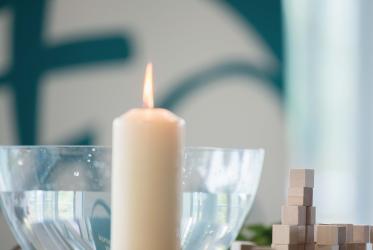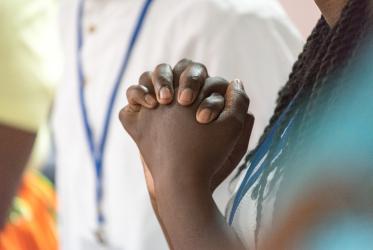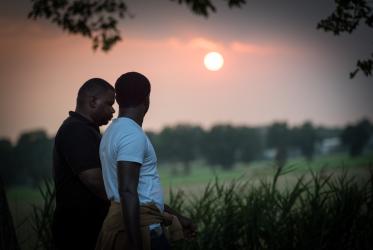When in Rome: Walking in the footsteps of early Christians and exploring the path of ecumenism today
December 2008
The WCC internship programme aims to equip young people for continued involvement in their church and the ecumenical movement. Interns work on assigned tasks in the different program areas of the Council. While they learn practical skills working at the WCC headquarters, they also participate in workshops and exposure trips to help them learn more about ecumenism, different Christian confessions, church history and intercultural cooperation. From 1-7 December 2008, three WCC interns and one intern from the World Student Christian Federation participated in a study visit to Rome, Italy and the Vatican City. The interns had an intensive week meeting with the Pontifical Councils for Interreligious Dialogue, Pastoral Care of Migrants and Itinerant People, Justice and Peace and Promoting Christian Unity. They traversed the city visiting various churches, the catacombs of Priscilla and other important historical Christian sites. The interns were also invited to meet and exchange views with people from the Focolare Movement, the Community of Sant'Egidio, the Centro Pro Unione and the Pontificio Ateno Sant'Anselmo. After the study trip, the interns have made some reflections about what this exposure in Rome means for each of them and the future of ecumenism
When one remembers Rome; the history; the culture; the food; the people; the growth; the rich; the poor; the church; the Roman Catholic Church; the power; the Pope; the art; the structures; the architecture; the list goes on of the stories seen and told of the abounding old and new city of Rome during our study visit. As a Pacific Islander, it certainly was an overwhelming experience to try to capture its essences in just a few days; because it's the type of place you only read about in textbooks and see in movies. I for one was quite taken by how much historical wealth and memories it holds. One thing is for sure, textbooks and movies do not do justice to what every building, basilica, statue, dome, pillar, ruin, artwork, street, step, door, room, tree, hallway, garden, had to say.
There are a lot of personal impressions and stereotypes of Rome and the Catholic Church that is hard to overlook. Obviously the enormous churches and basilicas said to be an expression of the beauty and majestic of God. I see it to be a display of power and the newly acquired intelligence of man. Another visible characteristic is the emphasis on religious icons and artwork. As a non-Catholic, at one point during our visit, I wanted to understand why so much emphasis and power was put onto one individual, the Pope. Is it for the same reason why Pacific Islanders have chiefs? Perhaps, I don't know. I do know however, how it felt when visiting the tomb of the late Pope John Paul II and overwhelmed by the emotions and atmosphere of the room. It almost seemed like he just passed away within the hour.
After our visit to various Pontifical Councils and groups, I got a glimpse of how much work and involvement the Catholic Church has in ecumenism. Over the years, even with as much power as it has, the Catholic Church has seen not only much success but also failure in its ecumenical work. From building and strengthening local communities to member churches breaking away from the Vatican, from providing mobile counselling and a space for interreligious dialogue to somewhat weakening intra-Christian relations, from successful partnerships with other organizations and churches to finding a common ground to cooperate peacefully.
Overall, we were welcomed with much Italian, Vatican and Catholic hospitality. Thanks to Father Gosbert and Giovanni.
The Vatican is vast. Not in terms of square meters but in terms of what it represents. Walking across the Peter's Square feels like every building in the little country in the middle of Rome is built to impress and make you submissive. No matter what denomination you confess yourself to it is hard to deny that the Vatican is one of the foremost religious symbols of the Lord Jesus Christ - or the super tanker of Christianity as one journalist called it.
Now, from a protestant perspective some things seem just a little bit too overwhelming, with gold clad church walls and extensively decorated churches. However, our host Fr Gosbert claimed, the people who constructed these buildings wanted to give everything they had to God - paying with sweat and sometimes death though.
As a protestant it is also not hard to get a little bit jealous on the catholicity and the unity they are able to show, at least most of the time. Some people also say that the Catholics are not really committed to ecumenism. If that is the case, they are very, very good at setting up a play projecting exactly that. The Pontifical Council for Christian Unity really provided us with a crash course in Catholicism.
The report by Antsa Rakotoarisoa is available only in French.
Please refer to the French version of this website.
It was my second visit to Rome but my first chance to travel with the interns this year and to be welcomed by the Pontifical Council for Promoting Christian Unity. One of the first meetings during the study visit to Rome was with the staff of the PCPCU. I was interested to know what they see as the major landmarks and successes of their ecumenical engagement. The PCPCU is engaged in several bilateral dialogues with different western and eastern Christian traditions. Much has been achieved in these dialogues since the Council's inception after the second Vatican Council which concluded in 1965. But one challenge remains, how is this cooperation manifested and understood at the grassroots level and in the every day life of Christians? This is precisely one of the challenges the PCPCU and the WCC are taking up through the Joint Working Group between the WCC and Roman Catholic Church. What I learned from our interaction is that we may need to rethink our approach in this area of ecumenical work. A certain amount of ecumenical cooperation can be achieved by expert theologians and church leaders, but how is this sustained, transferred and lived out? Does this knowledge remain in documents shelved away somewhere? Or is the reception of this ecumenical heritage lived out in our relationships with one another as Christians and in our ecclesial understandings? Furthermore, what is being learned from the local experience?
I wanted to learn more about the Roman Catholic Church while in Rome and I did. But there were many things I experienced which were outside of my expectations. I learned a lot about the early Christians while walking through the catacombs at St. Priscilla's and observing the ancient paintings on the walls. It is a humbling experience to be surrounded by ancient buildings and great works of art almost everywhere you goeach with an accompanying story. We attended the worship service of a Coptic Orthodox congregation housed in the basement of a Catholic church. This was one visible expression of ecumenical cooperation on a local level. In Saint Bartholomew's church, I saw the prayer book of Archbishop Oscar Romero of El Salvador. His prayer book along with many other objects have been collected as part of a project by the Sant'Egidio community to remember 20th and 21st century Christian martyrs. Standing in front of this prayer book was an unforgettable experience as Romero's Christian witness has profoundly influenced my own life.
There were the stories shared by our hosts when we asked them, "Why are you engaged in the work you are doing for the church and towards ecumenism? How did you get to where you are today?" At the Centro Pro Unione, we met in the same room where ecumenical participants of the Second Vatican Council made their deliberations. In Rome, I had the feeling of walking in the footsteps where Saints from the early days and ecumenists from more recent times have tread. This made me feel strengthened and part of something bigger.
As a group of non-Catholics, I was heart warmed and relieved by the patience of our hosts when we asked them all kinds of questions such as, "Where does the white smoke come from when a new Pope is chosen?" Sometimes, encountering difference (in this case theological, ecclesial and cultural differences) can be frightening and an even painful experience. This was certainly true for me. The trip to Rome was not a touristic getaway but one in which I had to confront my own stereotypes and ignorance. I also had to pose many difficult questions to myself and understand that despite all we can and do share as Christians, there are many divisions and obstacles to understanding one another. These points of tensions are precisely where learning takes place and where faith can be strengthened. Most impressive out of all the encounters was the way we were welcomed by the various communities and Pontifical Councils. I sensed a true desire for exchange and dialogue from our hosts and this was what made the experience meaningful.




